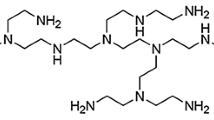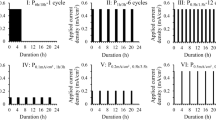Abstract
Purpose
As a continuing effort to understand the mechanisms of alternating current (AC) transdermal iontophoresis and the iontophoretic transport pathways in the stratum corneum (SC), the objectives of the present study were to determine the interplay of AC frequency, AC voltage, and iontophoretic transport of ionic and neutral permeants across human epidermal membrane (HEM) and use AC as a means to characterize the transport pathways.
Materials and Methods
Constant AC voltage iontophoresis experiments were conducted with HEM in 0.10 M tetraethyl ammonium pivalate (TEAP). AC frequencies ranging from 0.0001 to 25 Hz and AC applied voltages of 0.5 and 2.5 V were investigated. Tetraethyl ammonium (TEA) and arabinose (ARA) were the ionic and neutral model permeants, respectively. In data analysis, the logarithm of the permeability coefficients of HEM for the model permeants was plotted against the logarithm of the HEM electrical resistance for each AC condition.
Results
As expected, linear correlations between the logarithms of permeability coefficients and the logarithms of resistances of HEM were observed, and the permeability data were first normalized and then compared at the same HEM electrical resistance using these correlations. Transport enhancement of the ionic permeant was significantly larger than that of the neutral permeant during AC iontophoresis. The fluxes of the ionic permeant during AC iontophoresis of 2.5 V in the frequency range from 5 to 1,000 Hz were relatively constant and were approximately 4 times over those of passive transport. When the AC frequency decreased from 5 to 0.001 Hz at 2.5 V, flux enhancement increased to around 50 times over passive transport.
Conclusion
While the AC frequency for achieving the full effect of iontophoretic enhancement at low AC frequency was lower than anticipated, the frequency for approaching passive diffusion transport at high frequency was higher than expected from the HEM morphology. These observations are consistent with a transport model of multiple barriers in series and the previous hypothesis that the iontophoresis pathways across HEM under AC behave like a series of reservoirs interconnected by short pore pathways.






Similar content being viewed by others
References
Y. Song, S. K. Li, K. D. Peck, H. Zhu, A. H. Ghanem, and W. I. Higuchi. Human epidermal membrane constant conductance iontophoresis: alternating current to obtain reproducible enhanced permeation and reduced lag times of a nonionic polar permeant. Int. J. Pharm. 232:45–57 (2002).
G. Yan, S. K. Li, K. D. Peck, H. Zhu, and W. I. Higuchi. Quantitative study of electrophoretic and electroosmotic enhancement during alternating current iontophoresis across synthetic membranes. J. Pharm. Sci. 93:2895–2908 (2004).
G. Yan, K. D. Peck, H. Zhu, W. I. Higuchi, and S. K. Li. Effects of electrophoresis and electroosmosis during alternating current iontophoresis across human epidermal membrane. J. Pharm. Sci. 94:547–558 (2005).
S. K. Li, A.-H. Ghanem, K. D. Peck, and W. I. Higuchi. Pore induction in human epidermal membrane during low to moderate voltage iontophoresis: a study using AC iontophoresis. J. Pharm. Sci. 88:419–427 (1999).
G. Yan, S. K. Li, and W. I. Higuchi. Evaluation of constant current alternating current iontophoresis for transdermal drug delivery. J. Control. Release 110:141–150 (2005).
K. Okabe, H. Yamaguchi, and Y. Kawai. New iontophoretic transdermal administration of the beta-blocker metoprolol. J. Control. Release 4:79–85 (1986).
J. P. Howard, T. R. Drake, and D. L. Kellogg. Effect of alternating current iontophoresis on drug delivery. Arch. Phys. Med. Rehabil. 76:463–466 (1995).
R. Tapper. Iontophoretic treatment system. U.S. Patent 5,224,927, July 6, 1993.
H. Zhu, S. K. Li, K. D. Peck, D. J. Miller, and W. I. Higuchi. Improvement on conventional constant current DC iontophoresis: a study using constant conductance AC iontophoresis. J. Control. Release 82:249–261 (2002).
H. Zhu, K. D. Peck, D. J. Miller, M. R. Liddell, G. Yan, W. I. Higuchi, and S. K. Li. Investigation of properties of human epidermal membrane under constant conductance alternating current iontophoresis. J. Control. Release 89:31–46 (2003).
R. O. Potts, J. A. Tamada, and M. J. Tierney. Glucose monitoring by reverse iontophoresis. Diabetes Metab. Res. Rev. 18(Suppl 1):S49–S53 (2002).
J. A. Tamada, N. J. Bohannon, and R. O. Potts. Measurement of glucose in diabetic subjects using noninvasive transdermal extraction. Nat. Med. 1:1198–1201 (1995).
J. A. Tamada and K. Comyns. Effect of formulation factors on electroosmotic glucose transport through human skin in vivo. J. Pharm. Sci. 94:1839–1849 (2005).
S. K. Li, W. I. Higuchi, H. Zhu, S. E. Kern, D. J. Miller, and M. S. Hastings. In vitro and in vivo comparisons of constant resistance AC iontophoresis and DC iontophoresis. J. Control. Release 91:327–343 (2003).
H. Haga, T. Shibaji, and M. Umino. Lidocaine transport through living rat skin using alternating current. Med. Biol. Eng. Comput. 43:622–629 (2005).
T. Kinoshita, T. Shibaji, and M. Umino. Transdermal delivery of lidocaine in vitro by alternating current. J. Med. Dent. Sci. 50:71–77 (2003).
H. Inada, A-H. Ghanem, and W. I. Higuchi. Studies on the effects of applied voltage and duration on human epidermal membrane alteration/recovery and the resultant effects upon iontophoresis. Pharm. Res. 11:687–697 (1994).
S. K. Li, A.-H. Ghanem, and W. I. Higuchi. Pore charge distribution considerations in human epidermal membrane electroosmosis. J. Pharm. Sci. 88:1044–1049 (1999).
T. R. Mollee, Y. G. Anissimov, and M. S. Roberts. Periodic electric field enhanced transport through membranes. J. Membr. Sci. 278:290–300 (2006).
K. D. Peck, A.-H. Ghanem, W. I. Higuchi, and V. Srinivasan. Improved stability of the human epidermal membrane during successive permeability experiments. Int. J. Pharm. 98:141–147 (1993).
K. D. Peck, A.-H. Ghanem, and W. I. Higuchi. Hindered diffusion of polar molecules through and effective pore radii estimates of intact and ethanol treated human epidermal membrane. Pharm. Res. 11:1306–1314 (1994).
A. J. Bard and L. R. Faulkner. Electrochemical Methods: Fundamentals and Applications. New York: Wiley & Sons, 1980.
H. Zhu, K. D. Peck, S. K. Li, A. H. Ghanem, and W. I. Higuchi. Quantification of pore induction in human epidermal membrane during iontophoresis: the importance of background electrolyte selection. J. Pharm. Sci. 90:932–942 (2001).
Y. A. Chizmadzhev, A. V. Indenbom, P. I. Kuzmin, S. V. Galichenko, J. C. Weaver, and R. O. Potts. Electrical properties of skin at moderate voltages: contribution of appendageal macropores. Biophys. J. 74(2 Pt 1):843–856 (1998).
M. E. Johnson, D. Blankschtein, and R. Langer. Evaluation of solute permeation through the stratum corneum: lateral bilayer diffusion as the primary transport mechanism. J. Pharm. Sci. 86:1162–1172 (1997).
D. A. van Hal, E. Jeremiasse, H. E. Junginger, F. Spies, and J. A. Bouwstra. Structure of fully hydrated human stratum corneum: a freeze-fracture electron microscopy study. J. Invest. Dermatol. 106:89–95 (1996).
R. R. Warner, K. J. Stone, and Y. L. Boissy. Hydration disrupts human stratum corneum ultrastructure. J. Invest. Dermatol. 120:275–284 (2003).
Acknowledgments
This research was supported by NIH Grant GM 063559. The authors thank Watson Pharmaceuticals Inc. (Salt Lake City, UT) for their generous donation of some of the HEM samples used in the present study and Dr. Michael S. Roberts for his helpful discussion.
Author information
Authors and Affiliations
Corresponding author
Rights and permissions
About this article
Cite this article
Yan, G., Xu, Q., Anissimov, Y.G. et al. Alternating Current (AC) Iontophoretic Transport across Human Epidermal Membrane: Effects of AC Frequency and Amplitude. Pharm Res 25, 616–624 (2008). https://doi.org/10.1007/s11095-007-9405-2
Received:
Accepted:
Published:
Issue Date:
DOI: https://doi.org/10.1007/s11095-007-9405-2




